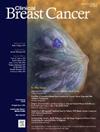前哨淋巴结阴性乳房切除术患者腋窝复发的 16 年中位随访:无放射治疗的自然史
IF 2.9
3区 医学
Q2 ONCOLOGY
引用次数: 0
摘要
前哨淋巴结活检(SLNB)阴性的乳房肿块切除术后腋窝复发非常罕见,这可能是由于常规使用全乳房放射治疗所致。在这项研究中,我们分析了SLNB阴性且未接受辅助放疗的乳房切除术患者的腋窝复发率。我们确定了因早期乳腺癌接受乳房切除术并行 SLNB 的女性(1999-2005 年),并纳入了病理结节阴性且未进行腋窝清扫或辅助放疗的患者。主要结果是同侧腋窝复发。共有 234 名妇女接受了 242 例乳房切除术,中位年龄为 50 岁。组织学显示,112例(46%)为浸润性癌症,16例(7%)为伴有微小浸润的原位导管癌(DCIS),114例(47%)为纯DCIS。癌症主要为雌激素受体阳性(59%)、中度(41%)或高度(32%)。最后切除的前哨结节平均为 2 个(1-6 个不等),有 21 名患者(9%)在 SLNB 病理检查中发现了孤立的肿瘤细胞。中位随访16年(1-22年不等),3名患者(1.2%)出现孤立性腋窝复发,1名患者同时出现腋窝和胸壁复发(总腋窝复发率为1.7%)。4例腋窝复发中的3例发生在雌激素受体阳性的中度或高度DCIS患者中,乳房切除术组织学检查未发现侵犯。腋窝复发的中位时间为70.5个月(29-132个月)。即使没有辅助放射治疗,SLNB 阴性后腋窝复发的情况也很罕见。这支持了早期乳腺癌和SLNB阴性患者放弃额外手术或腋窝放疗的安全性。本文章由计算机程序翻译,如有差异,请以英文原文为准。
Axillary Recurrence in Sentinel Lymph Node Negative Mastectomy Patients at 16 Years Median Follow Up: Natural History in the Absence of Radiation
Background
Axillary recurrence following lumpectomy with a negative sentinel lymph node biopsy (SLNB) is rare, possibly due to routine use of whole breast radiation. In this study, we characterized the rate of any axillary recurrence among mastectomy patients with a negative SLNB and no adjuvant radiation therapy.
Methods
We identified women who underwent mastectomy with SLNB for early-stage breast cancer (1999-2005) and included patients with pathologically negative nodes and no axillary dissection or adjuvant radiation. The primary outcome was ipsilateral axillary recurrence.
Results
A total of 234 women, median age 50 years, underwent 242 mastectomies. Histology showed 112 (46%) invasive cancers, 16 (7%) ductal carcinoma in-situ (DCIS) with microinvasion, and 114 (47%) pure DCIS. Cancers were predominantly estrogen receptor positive (59%) and moderate (41%) or high grade (32%). A mean of 2 final sentinel nodes were excised (range 1-6) and 21 patients (9%) had isolated tumor cells on SLNB pathology. At 16 years median follow up (range 1-22 years), 3 patients (1.2%) developed an isolated axillary failure, and 1 had concurrent axillary and chest wall recurrences (total axillary recurrence rate 1.7%). Three of four axillary recurrences occurred in patients with moderate or high-grade estrogen receptor-positive DCIS without invasion on mastectomy histology. Median time to axillary recurrence was 70.5 months (range 29-132 months).
Conclusions
Axillary recurrence is rare after a negative SLNB, even in the absence of adjuvant radiation. This supports the safety of forgoing additional surgery or radiation to the axilla in the early-stage breast cancer and a negative SLNB.
求助全文
通过发布文献求助,成功后即可免费获取论文全文。
去求助
来源期刊

Clinical breast cancer
医学-肿瘤学
CiteScore
5.40
自引率
3.20%
发文量
174
审稿时长
48 days
期刊介绍:
Clinical Breast Cancer is a peer-reviewed bimonthly journal that publishes original articles describing various aspects of clinical and translational research of breast cancer. Clinical Breast Cancer is devoted to articles on detection, diagnosis, prevention, and treatment of breast cancer. The main emphasis is on recent scientific developments in all areas related to breast cancer. Specific areas of interest include clinical research reports from various therapeutic modalities, cancer genetics, drug sensitivity and resistance, novel imaging, tumor genomics, biomarkers, and chemoprevention strategies.
 求助内容:
求助内容: 应助结果提醒方式:
应助结果提醒方式:


